Craftsman 316.79194 User Manual
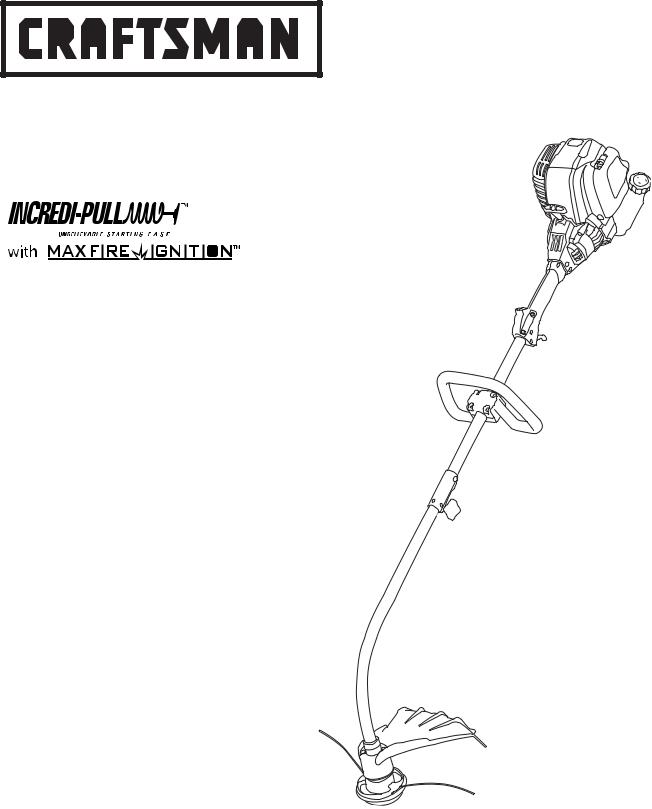
Operator’s Manual
®
4-Cycle
WEEDWACKER® GAS TRIMMER
Model No. 316.791940
CAUTION: Before using this product, read this manual and follow all safety rules and operating instructions.
•SAFETY
•ASSEMBLY
•OPERATION
•MAINTENANCE
•PARTS LIST
•ESPAÑOL, P. E1
Sears, Roebuck and Co., Hoffman Estates, IL 60179, U.S.A.
Visit our website: www.sears.com/craftsman
769-03539A
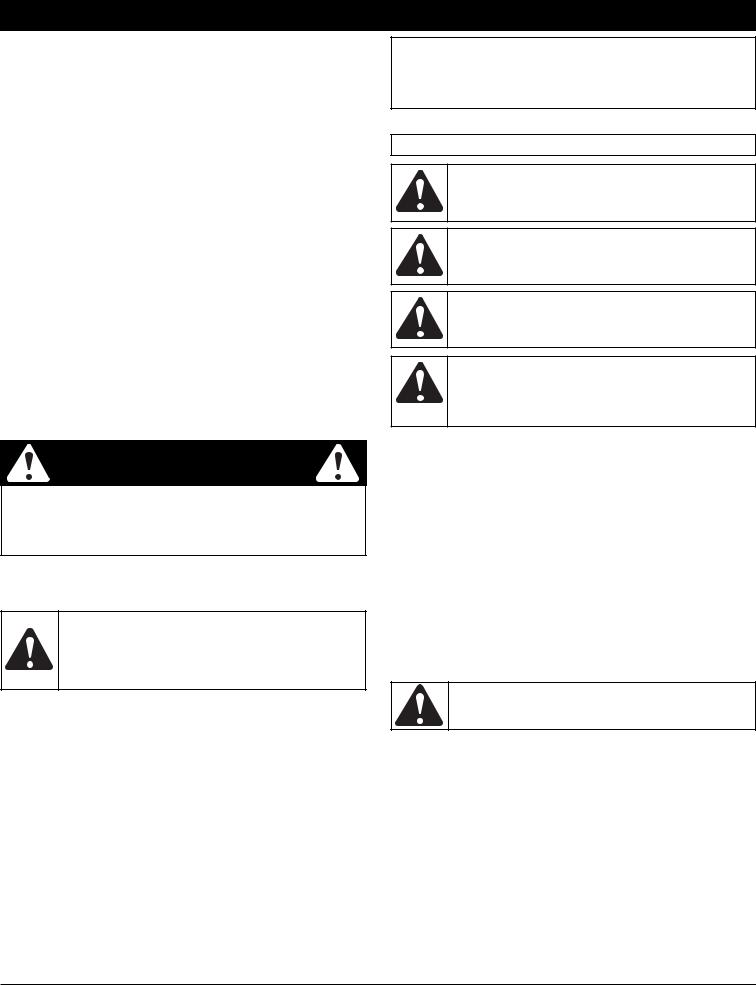
RULES FOR SAFE OPERATION
TABLE OF CONTENTS
Rules for Safe Operation . . . . . . . . . . . . . . . . . . . . . . . . . .2 Warranty Statement . . . . . . . . . . . . . . . . . . . . . . . . . . . . . .4 Assembly Instructions . . . . . . . . . . . . . . . . . . . . . . . . . . . .5 Know Your Unit . . . . . . . . . . . . . . . . . . . . . . . . . . . . . . . . .5 Oil and Fuel Information . . . . . . . . . . . . . . . . . . . . . . . . . . .6 Starting/Stopping Instructions . . . . . . . . . . . . . . . . . . . . . .7 Operating Instructions . . . . . . . . . . . . . . . . . . . . . . . . . . . .8 Maintenance and Repair Instructions . . . . . . . . . . . . . . . .9 Cleaning and Storage . . . . . . . . . . . . . . . . . . . . . . . . . . .13 Troubleshooting Chart . . . . . . . . . . . . . . . . . . . . . . . . . . .14 Specifications . . . . . . . . . . . . . . . . . . . . . . . . . . . . . . . . .14 Parts List . . . . . . . . . . . . . . . . . . . . . . . . . . . . . . . . . . . .E17 Service Numbers . . . . . . . . . . . . . . . . . . . . . . . .Backcover
SPARK ARRESTOR NOTE
NOTE: For users on U.S. Forest Land and in the states of California, Maine, Oregon and Washington. All U.S. Forest Land and the state of California (Public Resources Codes 4442 and 4443), Oregon and Washington require, by law that certain internal combustion engines operated on forest brush and/or grasscovered areas be equipped with a spark arrestor, maintained in effective working order, or the engine be constructed, equipped and maintained for the prevention of fire. Check with your state or local authorities for regulations pertaining to these requirements. Failure to follow these requirements could subject you to liability or a fine. This unit is factory equipped with a spark arrestor. If it requires replacement, ask a Sears or other qualified service dealer to install the Accessory Part #753-05297 Spark Arrestor Kit.
CALIFORNIA PROPOSITION 65 WARNING
WARNING
THE ENGINE EXHAUST FROM THIS PRODUCT CONTAINS CHEMICALS KNOWN TO THE STATE OF CALIFORNIA TO CAUSE CANCER, BIRTH DEFECTS OR OTHER REPRODUCTIVE HARM.
The purpose of safety symbols is to attract your attention to possible dangers. The safety symbols, and their explanations, deserve your careful attention and understanding. The safety warnings do not by themselves eliminate any danger. The instructions or warnings they give are not substitutes for proper accident prevention measures.
SYMBOL MEANING
SAFETY ALERT: Indicates danger, warning or caution. Attention is required in order to avoid serious personal injury. May be used in conjunction with other symbols or pictographs.
DANGER: Failure to obey a safety warning will result in serious injury to yourself or to others. Always follow the safety precautions to reduce the risk of fire, electric shock and personal injury.
WARNING: Failure to obey a safety warning can result in injury to yourself and others. Always follow the safety precautions to reduce the risk of fire, electric shock and personal injury.
CAUTION: Failure to obey a safety warning may result in property damage or personal injury to yourself or to others. Always follow the safety precautions to reduce the risk of fire, electric shock and personal injury.
NOTE: Advises you of information or instructions vital to the operation or maintenance of the equipment.
Read the Operator’s Manual and follow all warnings and safety instructions. Failure to do so can result in serious injury to the operator and/or bystanders.
FOR QUESTIONS, CALL
1–800–659–5917
• IMPORTANT SAFETY INSTRUCTIONS •
READ ALL INSTRUCTIONS BEFORE OPERATING
WARNING: When using the unit, you must follow the safety rules. Please read these instructions before operating the unit in order to ensure the safety of the operator and any bystanders. Please keep these instructions for later use.
•Read the instructions carefully. Be familiar with the controls and proper use of the unit.
•Do not operate this unit when tired, ill, or under the influence of alcohol, drugs, or medication.
•Children and teens under the age of 15 must not use the unit, except for teens guided by an adult.
•All guards and safety attachments must be installed properly before operating the unit.
•Inspect the unit before use. Replace damaged parts. Check for fuel leaks. Make sure all fasteners are in place and secure. Replace parts that are cracked, chipped, or damaged in any way. Do not operate the unit with loose or damaged parts.
•Carefully inspect the area before starting the unit. Remove all debris and hard or sharp objects such as glass, wire, etc.
•Be aware of risk of injury to the head, hands and feet.
•Clear the area to be cut before each use. Remove rocks, broken glass, nails, wire, string and other objects which may be thrown or become entangled in the cutting attachment. Clear the area of children, bystanders and pets; keep them outside a 50-foot (15 m) radius, at a minimum. Even then, they are still at risk from thrown objects. Encourage bystanders to wear eye protection. If you are approached, stop the unit immediately.
•Use only Hassle-Free™ XRTA QUIET Spiral Line. Never use metal-reinforced line, wire or rope. These can break off and become dangerous projectiles.
•Squeeze the throttle control and check that it returns automatically to the idle position. Make all adjustments or repairs before using unit.
FUEL SAFETY WARNINGS FOR GAS UNITS
WARNING: Gasoline is highly flammable, and its vapors can explode if ignited. Take the following precautions:
•Store fuel only in containers specifically designed and approved for the storage of such materials.
•Always stop the engine and allow it to cool before filling the fuel tank. Never remove the fuel tank cap or add fuel when the engine is hot. Never operate the unit without the fuel cap securely in place. Loosen the fuel tank cap slowly to relieve any pressure in the tank.
•Add fuel in a clean, well-ventilated outdoor area where there are no sparks or flames. Remove the fuel cap slowly, and only after the engine stops. Do not smoke while fueling. Wipe up any spilled fuel from the unit immediately.
•Avoid creating a source of ignition for spilled fuel. Do not start the engine until fuel vapors dissipate.
•Move the unit at least 30 feet (9.1 m) from the fueling source and site before starting the engine. Do not smoke. Keep sparks and open flames away from the area while adding fuel or operating the unit.
2
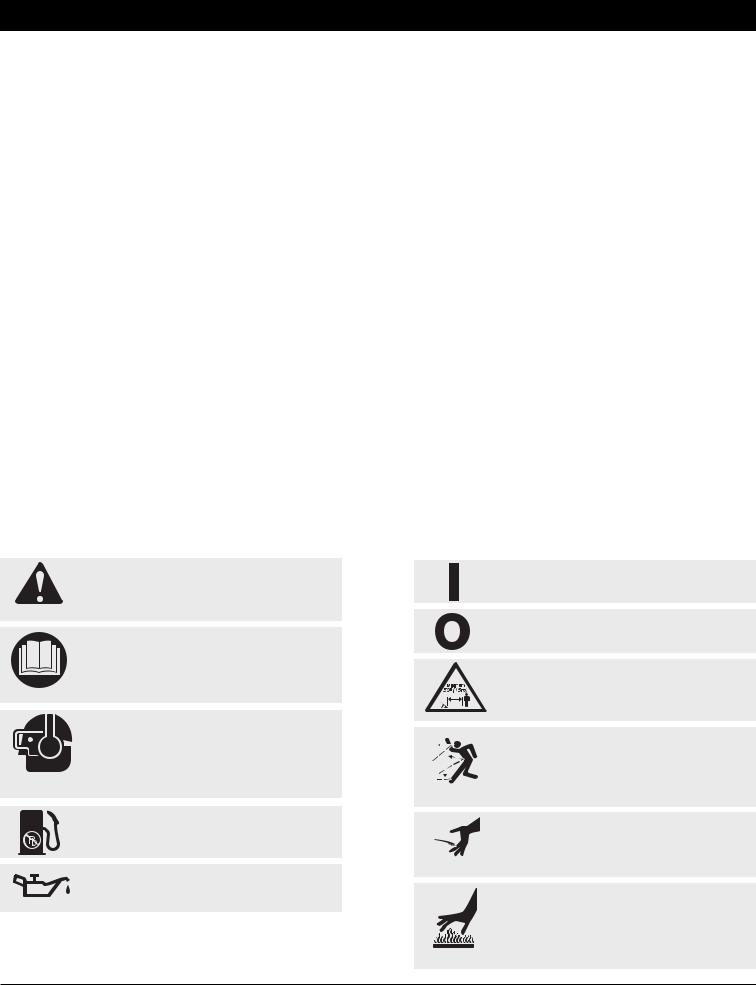
RULES FOR SAFE OPERATION
WHILE OPERATING
•Never start or run the unit inside a closed room or building. Breathing exhaust fumes can be fatal. Operate this unit only in a well-ventilated outdoor area.
•Wear safety glasses or goggles that meet ANSI Z87.1–1989 standards and are marked as such. Wear ear/hearing protection when operating this unit. Wear a face or dust mask if the operation is dusty.
•Wear heavy long pants, boots, gloves and a long sleeve shirt. Do not wear loose clothing, jewelry, short pants, sandals or go barefoot. Secure hair above shoulder level.
•The cutting attachment shield must always be in place while operating the unit as a trimmer. Do not operate unit without both trimming lines extended, and the proper line installed. Do not extend the trimming line beyond the length of the shield.
•This unit has a clutch. The cutting attachment remains stationary when the engine is idling. If it does not, take the unit to a Sears or other qualified service dealer for an adjustment.
•Adjust the D-handle to your size in order to provide the best grip.
•Be sure the cutting attachment is not in contact with anything before starting the unit.
•Use the unit only in daylight or good artificial light.
•Avoid accidental starting. Be in the starting position whenever pulling the starter rope. The operator and unit must be in a stable position while starting. Refer to Starting/Stopping Instructions.
•Use the right tool. Only use this tool for its intended purpose.
•Do not overreach. Always keep proper footing and balance.
•Always hold the unit with both hands when operating. Keep a firm grip on both handles or grips.
•Keep hands, face, and feet at a distance from all moving parts. Do not touch or try to stop the cutting attachment when it rotates.
•Do not touch the engine, gear housing or muffler. These parts get extremely hot from operation, even after the unit is turned off.
•Do not operate the engine faster than the speed needed to cut, trim or edge. Do not run the engine at high speed when not cutting.
•Always stop the engine when cutting is delayed or when walking from one cutting location to another.
•If you strike or become entangled with a foreign object, stop the engine immediately and check for damage. Do not operate before repairing damage. Do not operate the unit with loose or damaged parts.
•Stop the unit, switch the engine to off, and disconnect the spark plug for maintenance or repair.
•Use only replacement parts or accessories recommended for this tool that are distributed by Sears or a Craftsman outlet. Use of any replacement parts or accessories purchased elsewhere may be hazardous, and will also void your warranty.
•Keep unit clean of vegetation and other materials. They may become lodged between the cutting attachment and shield.
•To reduce fire hazard, replace a faulty muffler and spark arrestor. Keep the engine and muffler free from grass, leaves, excessive grease or carbon build up.
OTHER SAFETY WARNINGS
•Never store the unit with fuel in the tank, inside a building where fumes may reach an open flame (pilot lights, etc.) or sparks (switches, electrical motors, etc.).
•Allow the engine to cool before storing or transporting. Be sure to secure the unit while transporting.
•Store the unit in a dry area, locked up or up high to prevent unauthorized use or damage, out of the reach of children.
•Never douse or squirt the unit with water or any other liquid. Keep handles dry, clean and free from debris. Clean after each use, see
Cleaning and Storage Instructions.
•Keep these instructions. Refer to them often and use them to instruct other users. If you loan someone this unit, also loan them these instructions.
SAVE THESE INSTRUCTIONS
• SAFETY AND INTERNATIONAL SYMBOLS •
This operator's manual describes safety and international symbols and pictographs that may appear on this product. Read the operator's manual for complete safety, assembly, operating and maintenance and repair information.
SYMBOL MEANING
•SAFETY ALERT SYMBOL
Indicates danger, warning or caution. May be used in conjunction with other symbols or pictographs.
•READ OPERATOR'S MANUAL
WARNING: Read the operator’s manual(s) and follow all warnings and safety instructions. Failure to do so can result in serious injury to the operator and/or bystanders.
•WEAR EYE AND HEARING PROTECTION
WARNING: Thrown objects and loud noise can cause severe eye injury and hearing loss. Wear eye protection meeting ANSI Z87.1–1989 standards and ear protection when operating this unit. Use a full face shield when needed.
SYMBOL MEANING
•ON/OFF STOP CONTROL
ON / START / RUN
•ON/OFF STOP CONTROL
OFF or STOP
•KEEP BYSTANDERS AWAY
WARNING: Keep all bystanders, especially children and pets, at least 50 feet (15 m) from the operating area.
• THROWN OBJECTS AND ROTATING CUTTER CAN CAUSE SEVERE INJURY
WARNING: Do not operate without the cutting attachment shield in place. Keep away from the rotating cutting attachment.
•UNLEADED FUEL
Always use clean, fresh unleaded fuel
•OIL
Refer to operator’s manual for the proper type of oil.
•SHARP BLADE
WARNING: Sharp blade on cutting attachment shield. To prevent serious injury, do not touch the line cutting blade.
•HOT SURFACE
WARNING: Do not touch a hot muffler, gear housing or cylinder. You may get burned. These parts get extremely hot from operation. They remain hot for a short time after the unit is turned off.
3

WARRANTY STATEMENT
CRAFTSMAN® FULL WARRANTY
If this Craftsman® product fails due to a defect in material or workmanship within two years from the date of purchase, return it to any Sears store, Parts and Repair Service Center, or other Craftsman® outlet in the United States for free repair (or replacement if repair proves impossible).
This warranty applies for only 90 days if this product is ever used for commercial or rental purposes.
This warranty covers ONLY defects in materal and workmanship. Sears will NOT pay for:
•Expendable items that can wear out from normal use within the warranty period, such as cutting line, filters or spark plugs.
•Repairs necessary because of accident or failure to operate or maintain the product according to all supplied instructions.
•Preventive maintenance, or repairs necessary due to improper fuel mixture, contaminated or stale fuel.
This warranty gives you specific legal rights, and you may also have other rights which vary from state to state. Sears, Roebuck and Co., Hoffman Estates, IL 60179
Repair Protection Agreements
Congratulations on making a smart purchase. Your new Craftsman® product is designed and manufactured for years of dependable operation. But like all products, it may require repair from time to time. That’s when having a Repair Protection Agreement can save you money and aggravation.
Here’s what the Repair Protection Agreement* includes:
Expert service by our 10,000 professional repair specialists
Unlimited service and no charge for parts and labor on all covered repairs
Product replacement up to $1500 if your covered product can’t be fixed
Discount of 10% from regular price of service and related installed parts not covered by the agreement; also, 10% off regular price of preventive maintenance check
Fast help by phone – we call it Rapid Resolution – phone support from a Sears representative. Think of us as a “talking owner’s manual.” Once you purchase the Repair Protection Agreement, a simple phone call is all that it takes for you to schedule service. You can call anytime day or night, or schedule a service appointment online.
The Repair Protection Agreement is a risk-free purchase. If you cancel for any reason during the product warranty period, we will provide a full refund. Or, a prorated refund any time after the product warranty period expires. Purchase your Repair Protection Agreement today!
Some limitations and exclusions apply. For prices and additional information in the U.S.A. call 1-800-827-6655. *Coverage in Canada varies on some items. For full details call Sears Canada at 1-800-361-6665.
Sears Installation Service
For Sears professional installation of home appliances, garage door openers, water heaters, and other major home items, in the U.S.A. or Canada call 1-800-4-MY-HOME®.
4 |
4 |
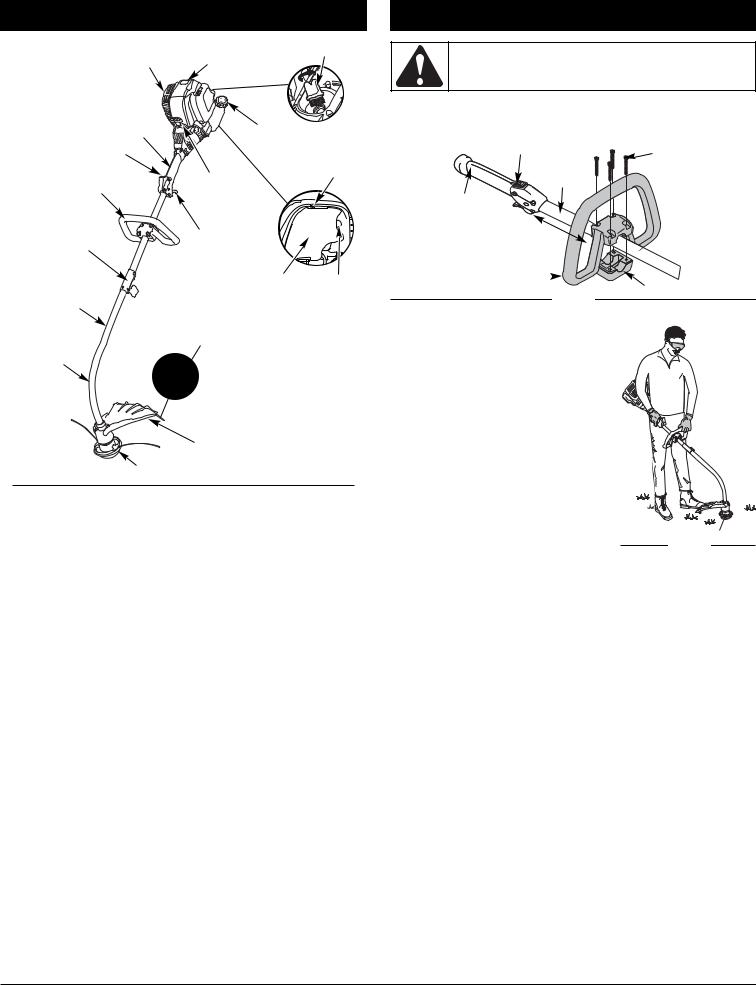
KNOW YOUR TRIMMER
Muffler |
Oil Fill Plug |
||
Spark Plug |
|
||
Shaft Grip |
Fuel |
|
|
On/Off Stop |
Cap |
Cold |
|
|
|||
Control |
|
Starting |
|
|
Starter |
Lever |
|
D-Handle |
|
||
Rope |
|
||
|
Grip |
|
|
Craftsman® |
Throttle |
|
|
Convertible™ |
|
||
Coupler |
Control |
|
|
Shaft |
Air Filter |
Primer |
|
Cover |
Bulb |
||
Housing |
|||
Line |
|
||
|
|
||
|
Cutting |
|
|
Trimmer |
Blade |
|
|
|
|
||
Attachment |
|
|
|
Cutting
Attachment Shield
HassleFree™
ASSEMBLY INSTRUCTIONS
WARNING: DO NOT ATTEMPT TO USE THIS UNIT UNTIL THE D-HANDLE HAS BEEN ROTATED INTO OPERATING POSITION (Fig. 1).
ADJUSTING THE D-HANDLE
1.Loosen the screws on the D-handle (Fig. 1).
On/Off Stop Control
Shaft
Housing
Shaft Grip
Minimum 6 Inches
(15.24 cm)
D-Handle 
Fig. 1
(4) Screws
Bottom Clamp
2.While holding the unit in the
operating position (Fig. 2), position the D-handle to the location that provides you the best grip.
3. Tighten the clamp screws evenly, until the D-handle is secure.
INSTALL LINE TRIMMER ATTACHMENT
NOTE: To make installation easier, place the unit on the ground or on a workbench.
1. Turn knob counterclockwise to loosen coupler (Fig. 15, p. 8).
2. While firmly holding attachment, push |
|
|
it straight into the coupler until the |
|
|
release button snaps into the primary |
Fig. 2 |
|
hole (Fig. 16, p. 8). |
||
|
NOTE: Aligning the release button with the guide recess (Fig. 16,
p.8) will help installation.
3.Turn the knob clockwise to tighten.
LINE TRIMMER APPLICATIONS
Cutting grass and light weeds; edging; and decorative trimming around trees, fences, etc.
5
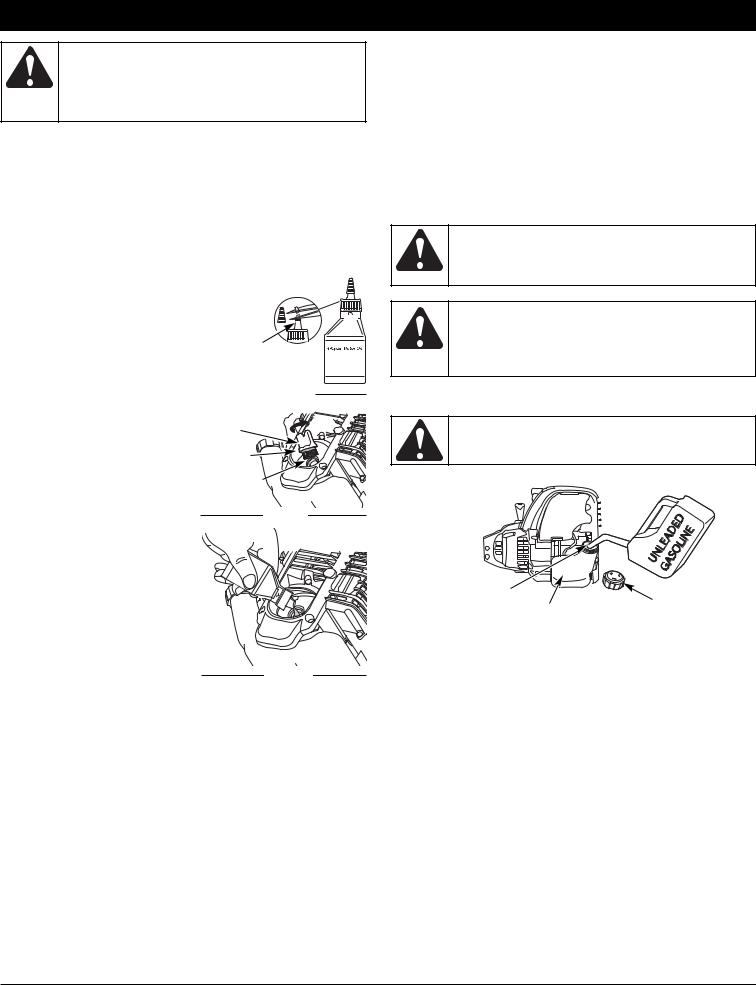
OIL AND FUEL INFORMATION
WARNING: OVERFILLING OIL CRANKCASE MAY CAUSE SERIOUS PERSONAL INJURY. Check and maintain the proper oil level in the crank case; it is important and cannot be overemphasized. Check the oil before each use and change it as needed. See Changing the Oil.
RECOMMENDED OIL TYPE
Using the proper type and weight of oil in the crankcase is extremely important. Check the oil before each use and change the oil regularly. Failure to use the correct oil, or using dirty oil, can cause premature engine wear and failure.
Use a high-quality SAE 30 weight oil of API (American Petroleum Institute) service class SF, SG, SH.
ADDING OIL TO CRANKCASE: INITIAL USE
NOTE: This unit is shipped without oil. In order to avoid damage to the unit, put oil in the crankcase before you attempt to start the unit.
Your unit is supplied with one 3.04 fluid oz. (90 ml.) bottle of SAE 30 SF, SG, SH oil (Fig. 3).
NOTE: Save the empty oil bottle. It |
Funnel |
|
|
|
|
|
|
|
|
|
|
|
can be used to measure the |
|
|
|
|
|
|
|
|
|
|
||
correct amount during future |
Spout |
|
||||||||||
oil changes. See Changing the |
|
|
|
|
|
|
|
|
|
|
|
|
Oil. |
|
|
|
|
|
|
|
|
|
|
|
|
|
Fig. 3 |
|
||||||||||
1. Unscrew the top of the bottle of |
|
|
||||||||||
|
|
|
|
|
|
|
|
|
|
|
|
|
|
|
|
|
|
|
|
|
|
|
|
|
|
oil and remove the paper seal |
Oil Fill |
covering the opening. Replace |
Plug |
the top. Next, cut the tip off the |
O-Ring |
funnel spout (Fig. 3). |
|
2. Tip unit so that the back of the |
|
engine is facing up in a vertical |
Oil Fill |
position. |
Hole |
3. Remove the oil fill plug from the |
Fig. 4 |
|
|
crankcase (Fig. 4). |
|
4. Pour the entire bottle of oil into the oil fill hole (Fig. 5).
NOTE: Never add oil to the fuel or fuel tank.
5. Wipe up any oil that may have spilled and reinstall the oil fill plug.
Check oil before each use and
change as needed. Refer to Fig. 5 Checking the Oil Level.
RECOMMENDED FUEL TYPE
Old fuel is the primary reason for improper unit performance. Be sure to use fresh, clean, unleaded gasoline. Dispose of the old gasoline in accordance to Federal, State and Local regulations.
NOTE: This is a four cycle engine. In order to avoid damage to the unit, do not mix oil with gasoline.
Definition of Blended Fuels
Today's fuels are often a blend of gasoline and oxygenates such as ethanol, methanol or MTBE (ether). Alcohol-blended fuel absorbs water. As little as 1% water in the fuel can form acids when stored. Use fresh fuel (less than 60 days old), when using alcohol-blended fuel.
Using Blended Fuels
If you choose to use a blended fuel, or its use is unavoidable, follow recommended precautions:
•Always use fresh unleaded gasoline
•Use a gas stabilizer fuel additive
•Drain tank and run the engine dry before storing unit
Using Fuel Additives
The use of a gas stabilizer will inhibit corrosion and minimize the formation of gum deposits. Using a fuel additive can keep fuel from forming harmful deposits in the carburetor for up to six (6) months. Add 0.8 oz. (23 ml.) of fuel additive per gallon of fuel according to the instructions on the fuel additive container. NEVER add fuel additives directly to the unit's gas tank.
WARNING: Add fuel in a clean, well ventilated outdoor area. Wipe up any spilled fuel immediately. Avoid creating a source of ignition for spilt fuel. Do not start the engine until fuel vapors dissipate.
WARNING: Gasoline is extremely flammable. Ignited vapors may explode. Always stop the engine and allow it to cool before filling the fuel tank. Do not smoke while filling the tank. Keep sparks and open flames at a distance from the area.
FUELING THE UNIT
1.Remove the fuel cap (Fig. 6).
WARNING: Remove fuel cap slowly to avoid injury from fuel spray. Never operate the unit without the fuel cap securely in place.
Gas Can Spout
Fuel Tank |
Fuel Cap |
|
|
||
|
|
|
|
Fig. 6 |
|
|
|
|
|
|
|
2.Place the gas container’s spout into the fill hole on the fuel tank (Fig. 6) and fill the tank.
NOTE: Do not overfill the tank.
3.Wipe up any gasoline that may have spilled.
4.Reinstall the fuel cap.
5.Move the unit at least 30 ft. (9.1 m) from the fueling source and site before starting the engine.
6

STARTING/STOPPING INSTRUCTIONS
WARNING: Operate this unit only in a wellventilated outdoor area. Carbon monoxide exhaust fumes can be lethal in a confined area.
WARNING: Avoid accidental starting. Make sure you are in the starting position when pulling the starter rope (Fig. 8). To avoid serious injury, the operator and unit must be in a stable position while starting.
STARTING INSTRUCTIONS
1.Check the oil level in the crankcase. Refer to Checking the Oil Level.
2.Fill the fuel tank with fresh, clean unleaded gasoline. Refer to Fueling the Unit.
NOTE: There is no need to turn the unit on. The On/Off Stop Control is in the ON ( I ) position at all times.
3. Fully press and release the primer bulb 10 times, slowly. Some amount of fuel should be visible in the primer bulb and fuel lines (Fig. 7). If you can’t see fuel in the bulb, press and release the bulb as many times as it takes before you can see fuel in it.
IF UNIT IS BELOW 40°F/4°C... Push the Cold Weather Start Lever (Fig. 7) down to the start/closed position. DO NOT push this lever down if the unit temperature is above 40°F/4°C.

 4. With the unit in the starting position (Fig. 8), do not squeeze the throttle control. Pull the starter rope out a short distance, until you feel some resistance. This is usually around 2-4 inches. Pull the starter rope out with a controlled and steady motion. Repeat this 5 times. The engine should start.
4. With the unit in the starting position (Fig. 8), do not squeeze the throttle control. Pull the starter rope out a short distance, until you feel some resistance. This is usually around 2-4 inches. Pull the starter rope out with a controlled and steady motion. Repeat this 5 times. The engine should start.
5.If engine starts, squeeze the throttle control to warm up the engine for 15 to 30 seconds. In cold weather, let the engine warm up for 30 to 60 seconds.
IF ENGINE STARTS AND WEATHER IS COLD... (below 40°F/4°C), lift the Cold Weather Start Lever back up to the run/open position.

 IF... the engine does not start, go back to step 3.
IF... the engine does not start, go back to step 3.

 IF... the engine stops while you are squeezing the throttle, go back to step 4.
IF... the engine stops while you are squeezing the throttle, go back to step 4.
WARM UNIT RESTART... Once the engine is warm, just pull the starter rope to restart. Do not squeeze the throttle control while pulling the starter rope.
NOTE: The unit uses the Incredi-Pull™ starting system with MAX FIRE IGNITION™ , which significantly reduces the effort required to start the engine. You must pull the starter rope out far enough to hear the engine attempt to start. There is no need to pull the rope briskly-- there is no harsh resistance when pulling. Be aware that this starting method is vastly different from (and much easier than) what you may be used to.
STOPPING INSTRUCTIONS
1.Release your hand from the throttle control. Allow the engine to cool down by idling.
2.Press and hold On/Off Stop Control in the OFF (O) position until engine comes to a complete stop (Fig. 9).
Cold Weather |
Primer Bulb |
|
Start Lever |
||
|



 Open
Open



 Closed
Closed
Fig. 7
Starter Rope 
Throttle Control
Fig. 8
Stop/Off (O)
Start/On (I)
Throttle Control
Fig. 9
7
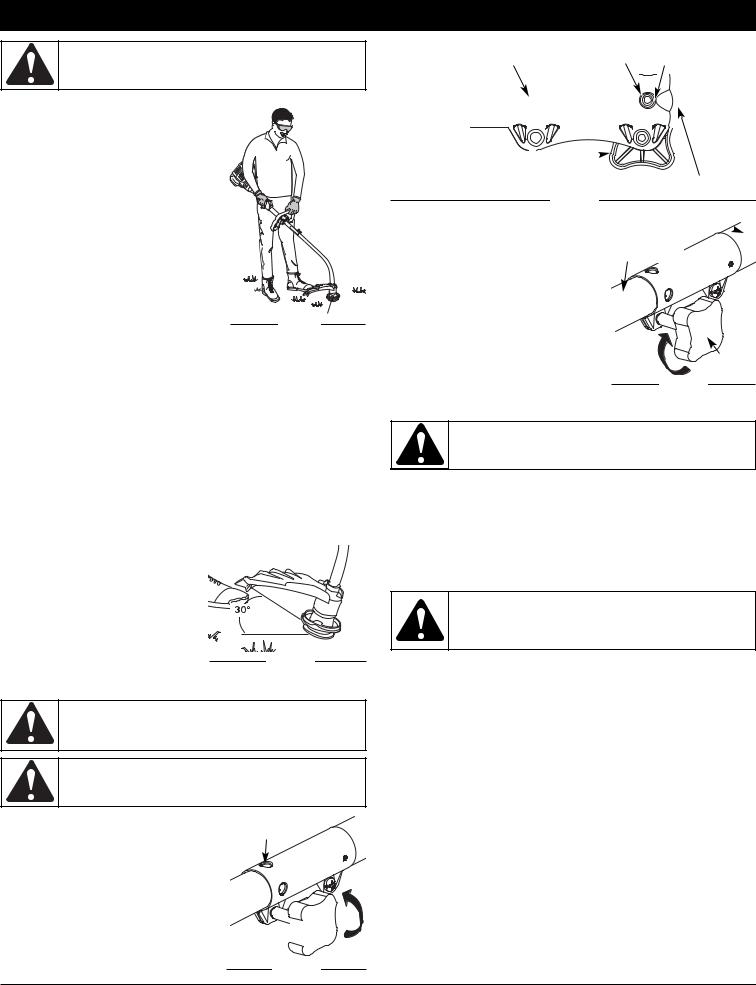
OPERATING INSTRUCTIONS
WARNING: Always wear eye, hearing, foot and body protection to reduce the risk of injury when operating this unit.
HOLDING THE TRIMMER
Before operating the unit, stand in the
operating position (Fig. 10). Check for the following:
• The operator is wearing eye protection and proper clothing
• With a slightly-bent right arm, the operator’s right hand is holding the
shaft grip
• The operator’s left arm is straight, the left hand holding the assist handle
• The unit is at waist level
• The cutting attachment is parallel to the
ground and easily contacts the grass without the need to bend over
TIPS FOR BEST TRIMMING RESULTS
• For best trimming results, operate unit with throttle control fully squeezed.
• Keep the cutting attachment parallel to the ground.
•Do not force the cutting attachment. Allow the tip of the line to do the cutting, especially along walls. Cutting with more than the tip will reduce cutting efficiency and may overload the engine.
•Cut grass over 8 inches (200 mm) by working from top to bottom in small increments to avoid premature line wear or engine drag.
•Cutting from right to left improves the unit's cutting efficiency. Clippings are thrown away from the operator.
•Slowly move the trimmer into and out of the cutting area at the desired height. Move either in a forward-backward or side-to-side motion. Cutting shorter lengths produces the best results.
•Trim only when grass and weeds are dry.
•The life of your cutting line is dependent upon:
–proper adherence of explained trimming techniques, what
–vegetation is cut, and
–where vegetation is cut.
For example, the line will wear faster when trimming against a foundation wall  as opposed to trimming around a tree.
as opposed to trimming around a tree.
DECORATIVE TRIMMING
Decorative trimming is accomplished by removing all vegetation around trees, posts, fences and more.
Rotate the whole unit so that the |
|
cutting attachment is at a 30° angle |
Fig. 11 |
to the ground (Fig. 11). |
USING THE CRAFTSMAN® CONVERTIBLE™ FEATURE
WARNING: Before you begin using any attachment, read and understand the manual that came with the attachment. Follow all safety information contained within.
WARNING: To avoid serious personal injury and damage to the unit, shut the unit off before removing or installing attachments.
You can convert this unit to edge grass.
1.Make sure the unit is turned completely off.
2.Turn the knob counterclockwise to loosen coupler (Fig. 12).
3.Push in the release button (Fig. 13) and twist the shaft 90° until the release button snaps into the 90° hole (Fig. 12).
4.Turn the knob clockwise to lock the coupler (Fig. 14).
90˚ Edging Hole
(Trimmer Only)
Coupler
Knob 


Fig. 12
Craftsman® |
Primary Hole |
|
Release Button |
|||||||||||||
Convertible™ Coupler |
|
|||||||||||||||
|
|
|
|
|
|
|
|
|
||||||||
|
|
|
|
|
|
|
|
|
|
|
|
|
|
|
|
|
|
|
|
|
|
|
|
|
|
|
|
|
|
|
|
|
|
|
|
|
|
|
|
|
|
|
|
|
|
|
|
|
|
|
|
|
|
|
|
|
|
|
|
|
|
|
|
|
|
|
|
|
|
|
|
|
|
|
|
|
|
|
|
|
|
|
|
|
Knob 
Guide Recess
Fig. 13
Upper Shaft 
Boom
Attachment
Knob
Fig. 14
CRAFTSMAN® CONVERTIBLE™ FEATURE
CAUTION: These attachments are to be snapped into the primary hole only. Using the wrong hole could lead to personal injury or damage to the unit.
The coupler allows you to convert this unit for use with the following attachments:
•Cultivator
•Blade Edger
•Blower
•Brush Cutter
•Pruner
To Install Attachments
CAUTION: Before operating this unit, be sure that the release button is fully snapped into the primary hole (Fig. 13), and that the knob (Fig. 14) is securely tightened.
NOTE: To make installation easier, place the unit on the ground or on a workbench.
1.Make sure the unit is turned completely off.
2.Turn the knob counterclockwise to loosen the coupler (Fig. 15).
3.While firmly holding the attachment, push it straight into the coupler until the release button (Fig. 16) snaps into the primary hole (Fig. 16). The primary hole is on the opposite side of the coupler from the knob (Fig. 16). Align the release button with the Guide Recess (Fig. 16) to help installation.
4.Turn the knob clockwise to tighten.
To Remove Attachments
1.Make sure the unit is turned completely off.
2.Turn the knob counterclockwise to loosen the coupler.
3.Press and hold the release button (Fig. 16).
4.While firmly holding the upper shaft boom (Fig. 17), pull the attachment out of the coupler.
8
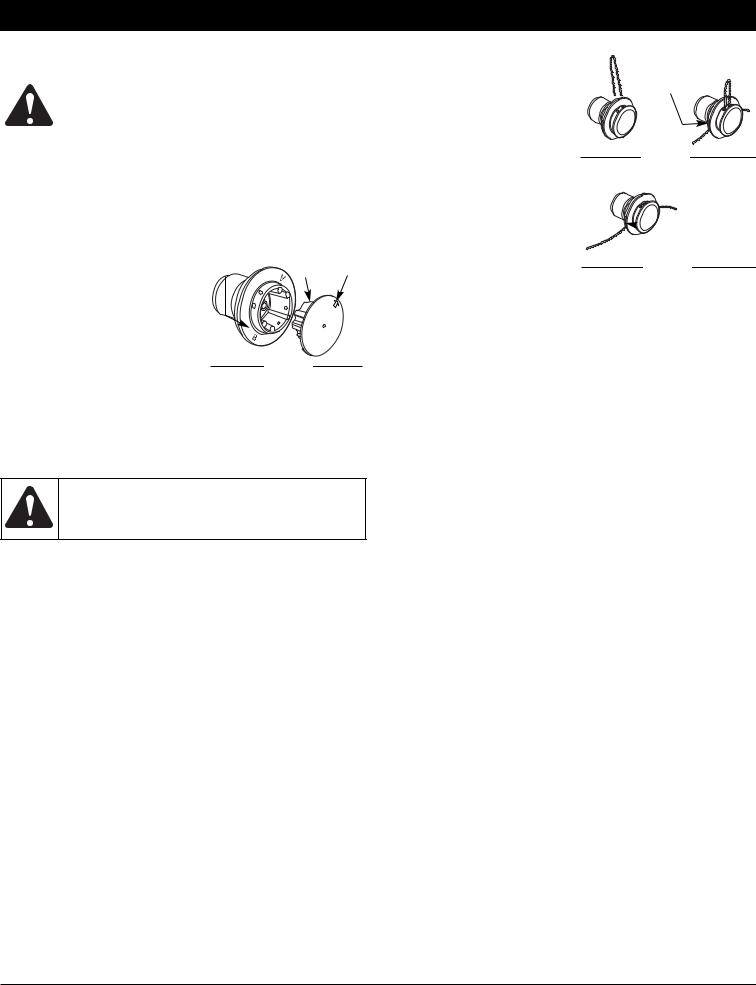
MAINTENANCE AND REPAIR INSTRUCTIONS
LINE REPLACEMENT |
4. Insert both ends of your line |
|
for Hassle-Free™ Cutting Head |
through the proper holes in |
|
|
|
the side of the cutting head |
|
WARNING: Do not remove or alter the line cutting |
(Fig. 16). |
|
blade assembly. Excessive line length will make the |
5. Pull the line and make sure the |
|
clutch overheat. This may lead to serious personal injury |
line is against the hub and is |
|
fully extended through the |
|
|
or damage to the unit. |
|
|
positioning tunnels (Fig. 17). |
|
|
|
|
|
|
|
Positioning
Tunnel
Always use Craftsman® Hassle-Free™ XTRA QUIET Spiral Line. Choose the line size best suited for the job at hand. Red colored line is designed for cutting grass and small weeds. Black colored line is designed for cutting larger weeds and light brush.
NOTE: Before inserting new line into the holes in the cutting head, identify the proper holes. Follow directions as shown on the line glide plate. Do Not attempt to remove the cutting head from the unit when replacing line.
1.Remove the old line and line glide plate from the cutting head.
2.Clean entire surface of cut-ting head. Note positions “A” and “B” on the cutting head.
3.Reinstall line glide plate (Fig. 15). Align arrow with:
“A” when using medium (red) or large (black) line, or
“B” when using lines with diameters smaller than medium (red) line
Cutting |
Line Glide |
Head |
Plate Arrow |
Fig. 15
NOTE: Line glide plate must be reinstalled in cutting head before inserting new line.
6.Correctly installed line will be the same length on both sides.
NOTE: Do not rest the HassleFree™ Cutting Head on the ground while the unit is running.
Some line breakage will occur from:
•Entanglement with foreign matter
•Normal line fatigue
•Attempting to cut thick, stalky weeds
Fig. 16
Line against 
 the hub
the hub
 Positioning
Positioning
Tunnel
Fig. 17
• Forcing the line into objects such as walls or fence posts
• MAINTENANCE SCHEDULE •
WARNING: To prevent serious injury, never perform maintenance or repairs with unit running. Always service and repair a cool unit. Disconnect the spark plug wire to ensure that the unit cannot start.
Perform these required maintenance procedures at the frequency stated in the table. These procedures should also be a part of any seasonal tune-up.
NOTE: Some maintenance procedures may require special tools or skills. If you are unsure about these procedures take your unit to a Sears or other qualified service dealer.
NOTE: Maintenance, replacement, or repair of the emission control devices and system may be performed by a Sears or other qualified service dealer.
In order to assure peak performance of your engine, inspection of the engine exhaust port may be necessary after 50 hours of operation. If you notice lost RPM, poor performance or general lack of acceleration, this service may be required. If you feel your engine is in need of this inspection, refer service to a Sears or other qualified service dealer for repair. DO NOT attempt to perform this process yourself as engine damage may result from contaminants involved in the cleaning process for the port.
FREQUENCY |
MAINTENANCE REQUIRED |
SEE |
|
|
|
|
|
Before starting engine |
Fill fuel tank with fresh fuel |
p. 6 |
|
Check oil |
p. 10 |
||
|
|||
|
|
|
|
Every 10 hours |
Clean and re-oil air filter |
p. 11 |
|
|
|
|
|
1st change at 10 hours |
Change oil |
p. 10 |
|
At 25 hours/every 25 hours |
Change oil |
p. 10 |
|
Every 50 hours |
Clean spark arrestor |
p. 13 |
|
|
|
|
|
10 hours on new engine |
Check rocker arm to valve clearance and adjust |
p. 12 |
|
Every 25 hours |
Check rocker arm to valve clearance and adjust |
p. 12 |
|
Every 25 hours |
Check spark plug condition and gap |
p. 12 |
|
|
|
|
9
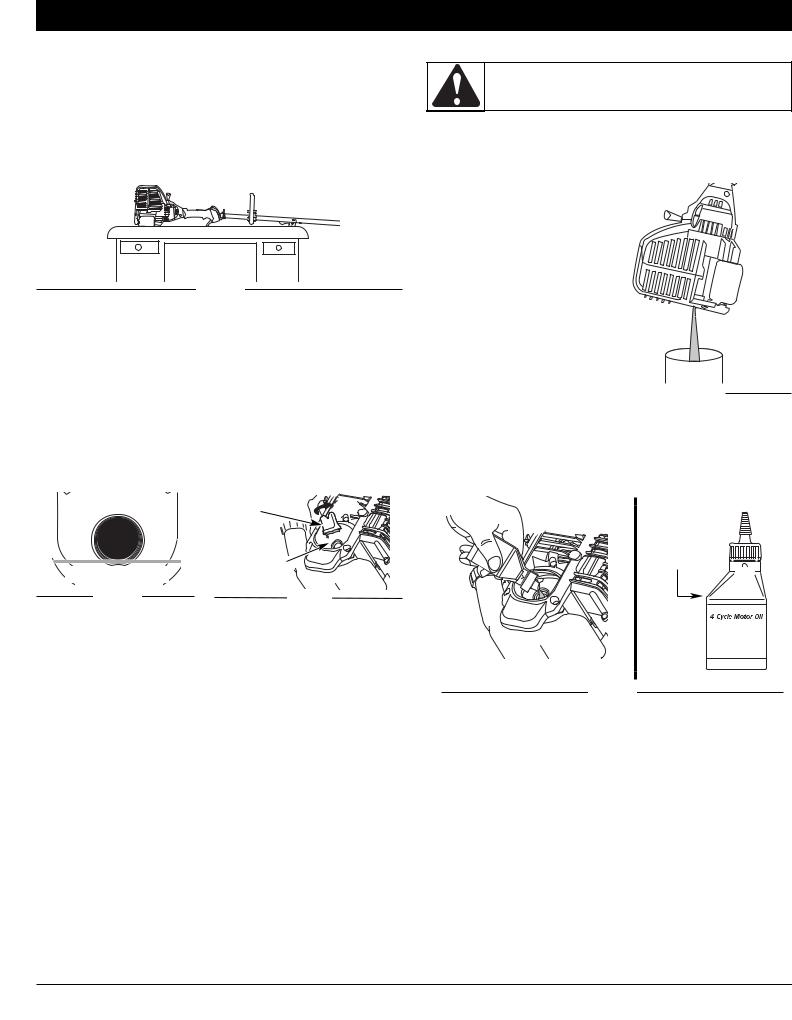
MAINTENANCE AND REPAIR INSTRUCTIONS
CHECKING THE OIL LEVEL
The importance of checking and maintaining the proper oil level in the crankcase cannot be overemphasized. Check oil before each use:
1.Stop the engine and allow oil to drain into the crankcase.
2.Place the engine on an elevated, level surface with the cutting head shield hanging off the surface to get a proper oil level reading (Fig. 18).
Fig. 18
3.Keep dirt, grass clippings and other debris out of the engine. Clean the area around the dipstick before removing it.
4.Remove the oil fill plug.
5.Look into the oil fill hole, use a flashlight if needed. The oil should be just touching the innermost thread (Fig. 19).
6.If the oil level is not touching the innermost thread on the oil fill hole, add a small amount of oil to the oil fill hole and recheck (Fig. 19). Repeat this procedure until the oil level reaches the innermost thread on the oil fill hole.
NOTE: Do not overfill the unit.
NOTE: Make sure the O-ring is in place on the oil fill plug when checking and changing the oil (Fig. 20).
Oil Fill Plug
O-Ring

Oil Fill Hole
Max Oil Fill Line
Fig. 19 |
Fig. 20 |
CHANGING THE OIL
WARNING: Wear gloves to prevent injury when handling unit.
For a new engine, change the oil after the first 10 hours of operation. Change the oil while the engine is still warm. The oil will flow freely and carry away more impurities.
1.Unplug spark plug boot to prevent accidental starting.
2. Remove the oil fill plug.
3. Pour the oil out of the oil fill hole and into a container by tipping the unit to a vertical position (Fig. 21). Allow ample time for complete drainage.
4.Wipe up any oil residue on
the unit and clean up any oil that may have spilled. Dispose of the oil according to Federal, State and local regulations.
5.Refill the crankcase with 3.04 fluid ounce (90 ml) of
SAE 30 SF, SG, SH oil. |
|
Fig. 21 |
|
NOTE: Use the bottle and spout saved from initial use to measure the correct amount of oil. The top of the label on the bottle measures approximately 3.04 ounces (90 ml) (Fig. 22).
Check the level; see Checking the Oil Level. If the level is low, add a small amount of oil and recheck. Do not overfill (Fig. 22).
Fill Level
Fig. 22
6.Replace the oil fill plug.
7.Reconnect the spark plug boot.
10
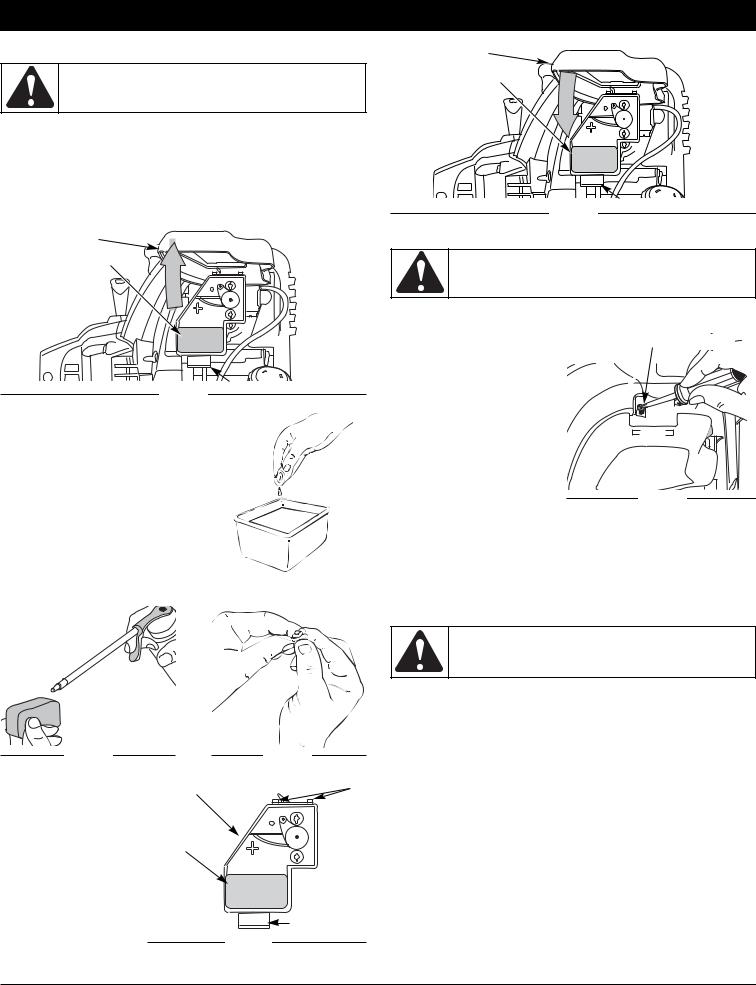
MAINTENANCE AND REPAIR INSTRUCTIONS
AIR FILTER MAINTENANCE
WARNING: To avoid serious personal injury, always turn the unit off and allow it to cool before you clean or service it.
Cleaning the Air Filter
Clean and re-oil the air filter every 10 hours of operation. It is an important item to maintain. Failure to maintain your air filter properly can result in poor performance or can cause permanent damage to your engine.
1.Open the air filter cover. Push the tab on the under side of the cover inward. Then pull the air filter cover out and up. (Fig. 23).
Air Filter Cover
Air Filter
Tab
Fig. 23
2.Remove the air filter (Fig. 23).
3. Wash the filter in detergent and water (Fig. 24). Rinse the filter thoroughly and allow it to dry.
4. Apply enough clean SAE 30 motor oil to lightly coat the filter (Fig. 25).
5. Squeeze the filter to spread and remove excess oil (Fig. 26).
6.Replace the filter (Fig. 23).
NOTE: If the unit is operated without |
|
|
|
|
the air filter, you will VOID the |
|
|
|
|
|
Fig. 24 |
|
||
warranty. |
|
|
||
|
|
|||
|
|
|
||
|
|
|
|
|
|
|
|
|
|
Fig. 25
7.Reinstall the air filter cover. Position the slots on the top of the air filter cover onto the tabs at the top of the back plate (Fig. 27).
8.Swing the cover down until the tab on the air filter backplate snaps into place in the slot on the air filter cover (Fig. 28).
|
Fig. 26 |
Back Plate |
Tabs |
|
|
Air Filter |
|
Locking Tab
Fig. 27
Air Filter Cover
Air Filter
Fig. 28 |
Tab |
|
IDLE SPEED ADJUSTMENT
WARNING: To prevent serious personal injury, make sure the cutting attachment has stopped rotating before you turn it off and set it down.
The idle speed of the engine is adjustable. An idle adjustment screw is between the air filter
cover and the engine starter housing (Fig. 29).
NOTE: Careless adjustments can seriously damage your unit. Aside from the idle speed, only a Sears or other qualified service dealer should make carburetor adjustments.
1. Check Fuel
Old fuel is usually the reason for improper unit performance.
Drain and refill the tank with fresh fuel prior to making any adjustments. Refer to Oil and Fuel Information.
2. Clean Air Filter
The condition of the air filter is important to the operation of the unit. A dirty air filter will restrict air flow. This is often mistaken for an out of adjustment idle. Check the condition of the air filter before adjusting the idle speed screw. Refer to Air Filter Maintenance.
3. Adjust Idle Speed Screw
WARNING: The cutting attachment may spin during idle speed adjustments. Wear protective clothing and observe all safety instructions to prevent serious personal injury.
If, after checking the fuel and cleaning the air filter, the engine still will not idle, adjust the idle speed screw as follows:
1.Start the engine and let it run at a high idle for a minute to warm up. Refer to Starting/Stopping Instructions.
2.Release the throttle trigger and let the engine idle. If the engine stops, insert a small phillips screwdriver in between the Air Filter Cover and the Engine Cover (Fig. 29). Turn the idle speed screw in, clockwise, 1/8 of a turn at a time (as needed) until the engine idles smoothly.
NOTE: The cutting attachment should not rotate when the engine idles.
3.If the cutting attachment rotates when the engine idles, turn the idle speed screw counterclockwise 1/8 of a turn at a time (as needed), until the attachment stops turning.
Checking the fuel, cleaning the air filter, and adjusting the idle speed should solve most engine problems. If not and all of the following are true:
•the engine will not idle
•the engine hesitates or stalls on acceleration
•there is a loss of engine power
Have the carburetor adjusted by a Sears or other qualified service dealer.
11
